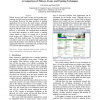Free Online Productivity Tools
i2Speak
i2Symbol
i2OCR
iTex2Img
iWeb2Print
iWeb2Shot
i2Type
iPdf2Split
iPdf2Merge
i2Bopomofo
i2Arabic
i2Style
i2Image
i2PDF
iLatex2Rtf
Sci2ools
GRAPHICSINTERFACE
2004
2004
Interacting with Big Interfaces on Small Screens: a Comparison of Fisheye, Zoom, and Panning Techniques
Mobile devices with small screens are becoming more common, and will soon be powerful enough to run desktop software. However, the large interfaces of desktop applications do not fit on the small screens. Although there are ways to redesign a UI to fit a smaller area, there are many cases where the only solution is to navigate the large UI with the small screen. The best way to do this, however, is not known. We compared three techniques for using large interfaces on small screens: a panning system similar to what is in current use, a two-level zoom system, and a fisheye view. We tested the techniques with three realistic tasks. We found that people were able to carry out a web navigation task significantly faster with the fisheye view, that the two-level zoom was significantly better for a monitoring task, and that people were slowest with the panning system. Key words: Large interfaces, small screens, mobile devices, screen space, zoom and pan, fisheye views.
Fisheye Views | GRAPHICSINTERFACE 2004 | GRAPHICSINTERFACE 2007 | Large Interfaces | Small Screens |
| Added | 30 Oct 2010 |
| Updated | 30 Oct 2010 |
| Type | Conference |
| Year | 2004 |
| Where | GRAPHICSINTERFACE |
| Authors | Carl Gutwin, Chris Fedak |
Comments (0)

